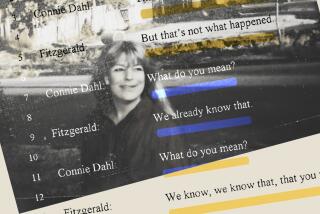Ng Takes Stand, Denies He Ever Killed Anyone
- Share via
In a dramatic move near the close of his marathon case, accused serial killer Charles Ng took the stand in his own defense Wednesday, insisting he wasn’t involved in multiple murders that took place 14 years ago in a remote Northern California cabin.
Telling his story in court for the first time, Ng suggested that the dozen murders were actually committed by Leonard Lake, a survivalist who lived in the cabin but committed suicide soon after his arrest in 1985.
Wearing an untucked shirt and slouching slightly over the stand, Ng repeatedly denied killing anyone but acknowledged that he helped Lake bury the body of one victim.
“There is a line I would not cross. Killing somebody, something serious, I wouldn’t do it,” he said.
Ng, 38, characterized his relationship with Lake as one of subservience.
“He was older than I was,” said Ng. “ . . . I’d follow his advice and respect his judgment. . . . I tried my best to conform to his expectations.”
Ng’s testimony came unexpectedly in the middle of closing arguments in what is one of California’s longest-running and most expensive murder cases. With the case about to go to the jury, Ng demanded that Orange County Superior Court Judge John J. Ryan allow him to testify--apparently against the best judgment of his own attorneys.
After a closed-door meeting with Ng early Wednesday, Ryan agreed to let the defendant take the stand and decided that prosecutors could present further closing statements after the testimony concludes.
“It’s extraordinary,” said Robert Pugsley, a professor at the Southwestern University College of Law, commenting on Wednesday’s developments. “But that same word can characterize the majority of this case. This is just further evidence of Ng’s ability to run circles around the judicial system and manipulate this process.”
Ng at times argued pretrial motions on his own behalf, and he tried repeatedly to dismiss his court-appointed lawyers--something critics said has contributed to the length of the case.
After Lake’s arrest, Ng fled to Canada, where he was caught shoplifting in Calgary. During that incident he shot a security guard and then served 4 1/2 years in prison for attempted murder.
American authorities demanded Ng’s extradition, but Canada does not have a death penalty law and is reluctant to extradite defendants to countries that do. The case created an uproar on both sides of the border with citizens demanding Ng’s transfer to California. Canada finally granted the extradition in September 1991, and Ng was moved quickly.
The case was moved to Orange County in 1994 because of pretrial publicity in Northern California.
Some family members of the victims, who were in court Wednesday, said they weren’t swayed by Ng’s testimony.
“The guiltier you are, the more you are going to try to pin it on someone else,” said Lola Stapley, the Garden Grove mother of Scott Stapley, one of 12 people Ng is accused of killing for financial gain and sexual gratification.
“That is the true sign of being guilty,” she added.
Ng’s testimony follows along the lines of the picture his attorneys have presented to the jury: their client as a dupe of Lake.
Many of the defense questions to Ng on Wednesday centered on allegations made by Joseph Maurice Laberge, a prison mate of Ng’s in Canada. Before he died in an auto accident, Laberge told authorities that Ng shared key details about the murders.
Ng on Wednesday strongly denied the alleged confession, dismissing Laberge as a “jailhouse snitch.”
Ng acknowledged knowing that Lake’s actions involved “illicit” activities, but claimed he didn’t know many details. He also said Lake showed him pictures of a bunker at the cabin where prosecutors say sex slaves were kept. But Ng said he thought the bunker was just part of Lake’s survivalist obsession.
Ng said he looked up to Lake, whom he met in the early 1980s. The two former Marines became friends, but Ng always considered Lake his superior.
“I looked at him as a person who was a senior to me,” Ng testified. “Because he had a higher ranking when he was discharged.”
On Monday during the prosecution’s closing arguments, state attorney Sharlene Honnaka had presented the jury with a cartoon Ng allegedly drew and gave to Laberege. The drawing depicted Ng sitting in a prison cell with the caption “San Quentin State Prison.” On the wall of the cell were pictures of his alleged victims and writing that read: “No kill, no thrill. No gun, no fun.” Honnaka characterized the drawing as an admission of guilt by Ng.
But on the stand Wednesday, Ng denied that contention. He said he may have written the captions but that Laberge had actually drawn most of the cartoon.
“It was a way to kill time,” Ng said, explaining that both were in solitary confinement and exchanged the cartoons back and forth, each drawing a portion.
The defense will continue its questioning of Ng today, after which the prosecution will begin its cross-examination.
Prosecutors began their case last year with with excerpts from a home video showing Ng and a partner allegedly threatening to kill two women unless they became the men’s sex slaves.
The videos were found in a remote Calaveras County cabin where Ng is accused of taking a dozen kidnapped victims, including two infants, and then killing and dismembering them.
On Wednesday, Ng testified that he helped Lake bury the body of Lonnie Bond Sr., 27. But he said he had never met Bond and was not involved in the killing. Bond was a neighbor of Lake’s in Wilseyville.
Ng said Lake “never suggested to me to help kill these people.”
More to Read
Sign up for Essential California
The most important California stories and recommendations in your inbox every morning.
You may occasionally receive promotional content from the Los Angeles Times.













